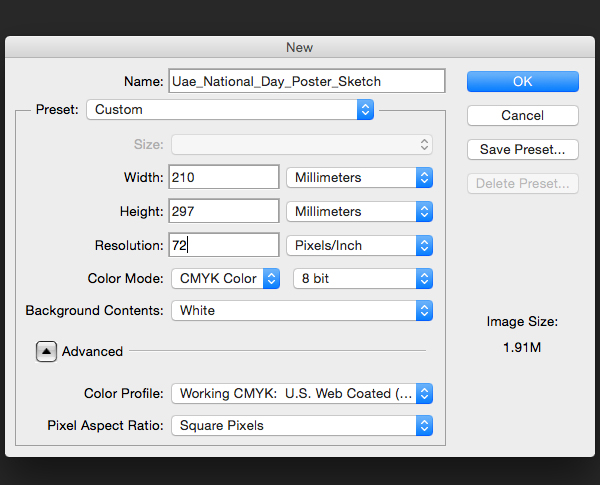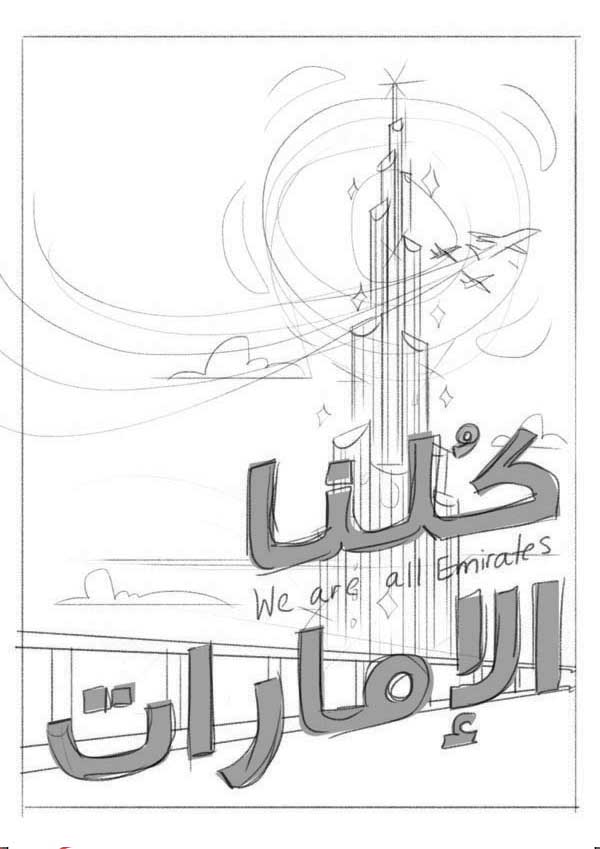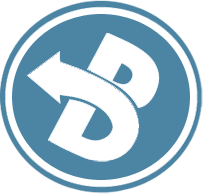 |
| What You'll Be Creating |
The day marks the UAE's formal nationalization, which was when the seven emirates were united under one flag to form the United Arab Emirates. The seven emirates (Abu Dhabi, Dubai, Sharjah, Ajman, Umm Al Qaiwain, Ras Al Khaimah, and Fujairah) are headed by Sheikh Khalifa bin Zayed Al Nahyan, the federation's president. Dubai being the largest and most popular Emirate, I’ve decided to create a National Day poster showcasing the city’s iconic landmark and the world’s tallest tower, Burj Khalifa.
In this tutorial, we will use some new Adobe Illustrator features and enhancements, as well as the more traditional tools, to create a festive graphic style poster for the UAE National Day holiday.
Let the celebrations begin!
1. Sketching & Setting Up
Step 1
We start by sketching out the idea for our design. I suggest you browse online for images of the UAE, Dubai, and Burj Khalifa tower, to help you visualize the elements for your creation. When I sketch, I normally use Photoshop CS6, and my Wacom Intuos Pro Pen tablet.In Photoshop CS6, open a new file: File > New (Command-N).
Name the file:
Uae_National_Day_Poster_Sketch.
Select Preset: International Paper, Size: A4, Color Mode: CMYK, set a Resolution of 72 Pixels/inch, and Background Contents: White. When the resolution is modified, you will see the Preset will change to Custom.
In case you are wondering why I sketched at 72 pixels, it is because I just wanted to roughly place in the outline of the artwork and not initially add in any details to the piece.

Step 2
Select the Brush Tool (B), with a greyish foreground color for your brush, and draw your basic concept on the artboard. Sketching with the grey brush helps you trace the sketch easily in Illustrator.I was visualizing the poster as being bright, edgy, and retro-inspired, with an architectural space theme. On the sketch I have added hand-drawn lettering of the Arabic translation of “We are all Emirates”.
With a wide round brush preset selected, color in the text area to give it a visual pop. Fill in the text area with the brush Mode set at Multiply.
Once your sketch is complete File > Save (Command-S) using the JPEG format, and move on to Illustrator CC.

Step 3
In Illustrator CC, create a new file: File > New (Command-N). Name it asUAE_National_Day_Poster,
set the Size to be A4, and click OK. 
Sketch so we can place in our sketch image.File > Place (Command-Shift-P), select the file
Uae_National_Day_Poster_Sketch.jpg, and click OK. You will notice a
graphics pointer appear, with a tiny preview of your selected image. Drag the
pointer, and click it on the upper left corner of your artboard, to place your sketch
on the artboard. Then double-click the Sketch layer, which will open the Layers
Options panel. Select Lock & Dim Images to 50%. Click OK.
Burj Khalifa, as we will start tracing
the tower’s first section.File > Save (Command-S), and save the file as
UAE_National_Day_Poster.ai.2. Tracing & Illustrating
Step 1
Let’s start drawing our tower. Select the Rectangle Tool (M), and with a black Stroke, and Fill set to None, draw a rectangle to measure up to the dimensions of one of the tower’s sections. Then with the Direct Selection Tool (A), drag the left upper corner downwards in order to slant the top, while holding down the Shift key to constrain the anchor vertically.
Just as the name implies, it divides all overlapping shapes into distinct, non‑overlapping shapes. It also groups the shapes together. Select the shape, Ungroup (Command-Shift G) and delete the excess shapes.




Step 2
Let's start coloring in our tower section.Select the rectangle, and here’s a nice little trick to copy and paste an object in place. The keyboard shortcut for this is Command-C for Copy, and Command-F for Paste in Front and Command-B for Paste to Back. Make sure you Paste to Back. You won’t see the action, but if you drag the selection to the side you will notice the pasted copy right behind. Once you’ve duplicated the rectangle, do the same with the top half circle.

In the Gradient panel, select Type: Linear, Angle: -90°, and give the gradient sliders a red tone from light red to a darker shade, Stroke (X) to None. Then drag the gradient swatch from the Gradient panel onto the Swatches panel to save it, in case we need to use the same gradient at a later stage.
Select both half circles, and Object > Arrange > Bring to Front (Command-Shift-]), so we can cover the line segments. Give the lower half circle a flat pink-red color, and keep the one on top with a black stroke.
With one of the black stroke lines selected, Select > Same > Stroke Color, and you will find that this action selects all shapes with black strokes. Deselect the borderlines, by just holding down the Shift key. Group (Command-G) the inner lines together, and give them an orange-red stroke of 0.3 pt weight.
Windows > Transparency, and give the strokes a Screen: Blending Mode.

You will notice while browsing images of the Burj Khalifa that some of the towers' floors are highlighted, so we need to mimic that effect. Select All (Command-A), and Lock Selection (Command-2). Take the Pen Tool (P) and freehand draw a curved rectangular shape to fill at least three or four floors. Fill in with red and a Blending Mode: Screen. Object > Unlock all (Command-Option-2), and arrange the screened highlights to be behind the white borderlines.

I wanted to give the tower the colors of the UAE flag: Red, Green, White and Black. However, black is too aggressive, and white won’t showcase clearly, so I worked on red, green, and white-bluish gradients.
Note: Each time you create a section, modify the arrangement to be behind the other section.
When you reach the top of the tower, it’s best you downsize the stroke weight of your lines, and for the head of the tower, just draw in vertical rectangles, with the Rectangle Tool (M).
Once you are done, Select All (Command-A) and Group (Command-G) all the tower elements together. File > Save (Command-S).

Step 3
Lock the Burj Khalifa layer, create a new layer, and name itText.Select the Type Tool (T), with a font size of about 43 pt, and type in the English text,
We are all Emirates, with the desired font. I worked
with Nova font, which you can download free.Next, I notice some of the letters need space between them, so I use the Touch Type Tool (Shift-T) and select the I, S and L in the sentence to add in some breathing space between each letter.

Take the Type Tool (T), and type in the Arabic text, set at 50 pt font weight. Make sure Paragraph Direction is set to Right-to-Left Direction, because Arabic reads from right to left.


Lock and hide the Text layer, and create a new layer above Sketch. Name it
Background.Step 4
In our background layer, we need to trace the remaining elements. So select the Pen Tool (P) and start tracing all the other elements.For the bridge, draw a long rectangle using the Rectangle Tool (M), then hold down Shift and Alt. With both rectangles selected, click the Free Transform Tool (E). The free transform widget will appear with the button options to constrain, free transform, perspective distort, and free distort. Select Perspective Distort.
You will notice Perspective Distort is constrained, so there's no need to hold the Shift key when moving the anchors. To help you align the results the way you want, click Free Distort, and align accordingly.


Unlock the Burj Khalifa layer. Select the rail and the bridge ground and drag them to the Burj Khalifa layer to cover the tower's lower section. File > Save (Command‑S).
Now we need to color the rest of the poster, so we can start visualizing it better.

3. Color
Step 1
Dubai has sun all year long, so we need to work with a bright color palette for the background, yet we need it to blend with the flag’s palette. For the background sky color, I chose a yellowish gradient, and the other shapes were either white, yellow, or in accordance with the UAE flag color hues.
Now the illustration is starting to come to life.

When we expanded the Arabic text, all the elements were grouped together. So, Ungroup (Command-Shift-G) and then select each word’s letters and create a compound shape by selecting the Pathfinder panel: Unite. In the Pathfinder Panel Options, you will find in the drop-down menu the Make Compound Shape option. Select this option, and then hit the Expand button on the Pathfinder panel, so the shape is unified.
For the English text, Unite the whole sentence together.

The English text looks squeezed in between the Arabic, so I decided to drag it below the Arabic, and I brought the Arabic text closer. With the Arabic text selected, Object > Path > Offset path at 2.2 mm, Round, and OK, to give it a border.



Step 2
Let’s add some effects to the text.Draw two ovals with the Ellipse Tool (L) to mimic the curve of a light flare. Copy (Command-C), and Command-F to Paste in Front. From the Pathfinder panel, select Shape Mode: Intersect to create a compound shape from the two intersecting forms. Delete the extra oval. Give the new shape a black to grey gradient with an Angle: -90°.
Render the same effect for the lower text.

Step 3
Lock the Text layer, and unlock the Background and Burj Khalifa layers.You may need to tweak some of your elements on the Background layer, so that they look in harmony. I thickened the borderlines of my tower, sheared my bridge form, gave the clouds a white fading gradient, adjusted the color and shape of the sun, and modified the jet planes. Once you are satisfied with the overall image, you can move on to add some sparkle to the scene.
Lock your Background layer and move onto the Burj Khalifa layer.
Step 4
Hold and click your Rectangle Tool button, and select the Star Tool from the bin.Click once on your artboard and the Star Option window will appear.
Fill in Radius 1: 0.5 mm, Radius 2: 7 mm, and Points: 8. Click OK.

Draw another sparkle, with the Ellipse Tool (L). Create a white fill circle, Effect > Distort & Transform > Pucker and Bloat. Give it a Pucker of -155%, and a Screen Blending Mode.

Step 5
Draw a few more circles of different shapes around, give them gradients and Screen blending modes.Open Windows > Symbols.
Drag the batch of stars and circles onto the Symbols panel to create a new symbol. Keep the settings in your Symbol Options, name the symbol
Sparkle and click OK.

Step 6
We are almost done.Unlock all the layers, Select All (Command-A) and Group (Command-G) all the artwork and text together. Everything will move into the Text layer.
Delete the empty layers.
With the Rectangle Tool (M), draw a rectangle in the middle of the artboard, so that we can mask the artwork.
You may have to move or scale the grouped artwork, in order to capture everything inside the rectangle.
Select the rectangle and the grouped artwork, Object > Clipping Mask > Make (Command-7). Now the artwork looks as if it’s framed.
Done!
Voila, the festive National Day Poster is done! Let’s celebrate.File > Print (Command-P), and paste it around your neighborhood.






